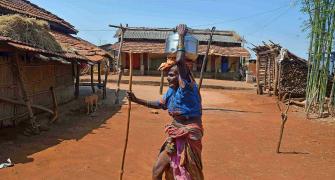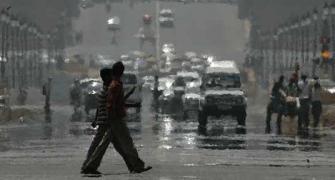'If because of El Nino, the monsoon is affected adversely in the current year, naturally it will affect income projections and consequently Budget numbers.'

Dr C Rangarajan has been governor of the Reserve Bank of India, chairman of the 12th Finance Commission and head of the prime minister's Economic Advisory Council to guide and direct the economy.
"The problem in assessing the poverty ratio after 2011-2012 has been the absence of required data... Committees have been appointed by the government from time to time to look into the methodology for the estimation of poverty ratio. The last committee was headed by me and no action has been taken on the report submitted in 2014," Dr Rangarajan, who is now in his nineties, tells Indivjal Dhasmana/Business Standard.
The concluding segment of a two-part interview:
While the India Meteorological Department has said that the monsoon would be normal this year, Skymet has said there is a 60 per cent probability of drought.
In case the monsoon turns out to be sub-normal, how do you see agriculture growth, rural distress and its overall impact on the larger economy?
The impact of El Nino is always a matter of concern. The predictions on its appearance vary.
If because of El Nino, the monsoon is affected adversely in the current year, naturally it will affect income projections and consequently Budget numbers.
We have had a good run on agriculture for several years continuously.
Even though agriculture contributes less than 15 per cent to GVA (gross value added), a poor performance in agriculture diminishes production of vital food grains and also reduces rural demand for industrial consumption goods.
The reduction in overall growth rate may affect revenue projections.
Besides, government expenditure may also increase through additional allocation to MNREGA (Mahatma Gandhi National Rural Employment Guarantee Scheme) and other relief measures.
The impact obviously depends upon the severity of monsoon failure, if there is one.
The World Trade Organization has projected goods trade growth to slow to 1.7 per cent by volume in calendar year 2023, from 2.7 per cent in 2022.
What effect will it have on our merchandise exports for 2023-2024?
Merchandise exports showed a negative growth in six months in 2022-2023.
India's merchandise export performance in 2023-2024 will depend on the growth performance of developed countries which is not expected to improve.
In fact, the global growth rate is projected to decline.
If the global volume of trade is expected to fall, our exports growth may also fall unless we raise our share in world exports.
India's current account deficit has remained more comfortable because of the lower growth in merchandise imports, rise in service exports and remittances.
Perhaps the same story may repeat itself in 2023-2024.
A section of political voices has called for reforming GST by introducing one rate only with minimum tariff.
Leaving the politics of that appeal aside, how do you view this kind of GST?
GST as a tax holds many merits and that is why it is recommended for adoption by all countries.
But the induction of GST in India has had many twists and turns. We have multiple rates.
One claimed the merit of GST is its simplicity. This simplicity is supposed to flow from a single rate for all commodities.
This does away with the need to define and specify commodities. But it is not easy to find acceptance of this view.
We are not writing on a clean slate. We have had a long history of commodity taxation.
There is always a dispute whether essential goods and luxury goods should be taxed at the same rate.
What we can do is to strive towards a structure of three rates -- one standard rate, one below for essential goods and one above for luxury goods.
Even this will take a long time to achieve. What is comforting at the present moment is that we have finally reached a stage of raising adequate revenue.
What impact do you envisage from the collapse of some banks such as Silicon Valley Bank in the US on the Indian financial system?
Should India have some kind of regulatory framework for the yield inversion kind of situations?
I do not see any immediate impact on India of the collapse of banks such as SVB.
So long as the US financial system is not affected, there will be no contagion effect.
The failure of SVB has lessons for banks not only in the US but also elsewhere.
The excessive concentration of certain types of customers in deposits, high proportion of uninsured deposits and credit expansion in select risky activities are aspects which all banks have to take note of.
There are also lessons for policy makers and regulators.
One vulnerability of SVB was because of the fall in the value of fixed income securities including government securities due to sharp rise in interest rates.
Meeting the liquidity requirements could be done only at a loss.
Some warning signal from the Fed should have gone at the beginning of the rise in the interest rate cycle.
Various estimates of poverty have come out recently. Some estimated that poverty has increased since Covid struck during 2020-2021, others held divergent views.
As an economist who headed a committee on poverty estimates, what is your estimate?
The problem in assessing the poverty ratio after 2011-2012 has been the absence of required data.
In India, the traditional method has been to estimate the poverty ratio from the consumption expenditure surveys.
From these surveys, we can derive size wise distribution of consumption expenditures and by using a cut-off line for poverty it is feasible to estimate poverty ratio.
Committees have been appointed by the government from time to time to look into the methodology for the estimation of poverty ratio.
The last committee was headed by me and no action has been taken on the report submitted in 2014.
The survey on consumption expenditures done in 2017-2018 have not been released officially.
In the absence of such data, many analysts have used alternative data to estimate poverty ratio and have come up with differing conclusions.
In the current year, the consumption expenditure survey is being conducted.
For purposes of comparison, we need to follow one method.
It is therefore best to wait for the survey results to be published.
Earlier surveys clearly indicate that the poverty ratio comes down strongly during a period of high growth.
Using the Tendulkar methodology, estimates show the poverty ratio fell from 37.2 per cent in 2004-2005 to 21.9 per cent in 2011-2012.
This was the period during which India's growth rate as mentioned previously was high.
The Oxford Study on Multidimensional Indicator Index for poverty also confirms this trend.
If you look at the recent years including Covid period, the growth rate has come down.
There is ground to believe that the rate of reduction in the poverty ratio must have slowed down.
This is at best a guess. We need to wait for consumption expenditure survey data.










